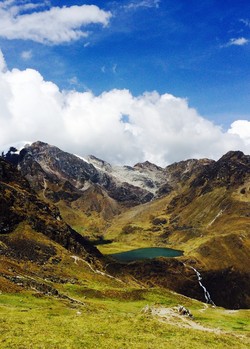
Like many of us whose hearts have been given over to God’s reconciling work in healing the creation, I have heard many, many presentations on climate change. For at least 15 years, I have been intentionally studying and hearing about the science of it, the moral imperative behind it, the actions we can take, and the change we want to accomplish. I do not really tire of any of it. It is always good to be in a place (especially with new language, new people, new context) to affirm the things we have heard and know.
Yet, my body and heart want more. I sit in seats at powerful conferences, hearing panel presentations, watching PowerPoints, hearing good arguments, and something in me still is yearning. We have heard so many facts, the charts of ocean currents and water cycle, the terrible statistics about natural disasters increasing, about displaced climate refugees. It is crucial that we understand and know the dangers, that we face the hard realities, that we examine root causes and explicate possible paths forward.
I’m just not convinced that meetings and talking are going to get us there. I don’t think continuing to listen to a moderator and 4 panelists, over and over, is the only thing we can do, if the world is going to change. Whose model is it, and where has it proven effective? (We are, after all, at the COP 20. Yes, 20. 20 huge meetings, with a huge carbon footprint, with many smaller meetings in-between.)
Don’t get me wrong. I am a prodigious note-taker. I have notebooks full of important quotes, from years ago and from this trip to Peru, too. I love words, I write words, I read words, I collect them.
But in the end, I think: what are the things that truly make me convicted of the need for my own personal change, things that will convert me long after my mind forgets the words? It is fairly seldom that I’m truly changed by an articulate statement from a politician or a brilliant lecture from someone in a suit behind a podium.
I am changed by: seeing the smile mixed with anguish on Nelson’s face, a man who loves life and children and his country and wants to protect them from damage.
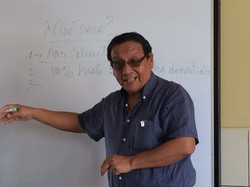
I am changed by: the kind spirit of Sister Gayatri Naraine, a compassionate woman in a flowing white garment who touches her heart and urges us to see that what matters is our inner resilience that springs from a loving and conscious relationship with the earth.
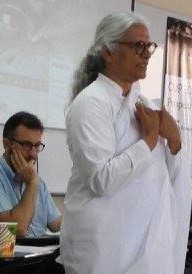
photo from Colleen Earp
For me, I am awakened and convicted by the music and dance of neighbors in the climate march, bringing rhythms from various continents to enter our souls and shake them up. I am touched by clasping hands with a new Filipino colleague, smiling and knowing we share a passion for the world, even as the crowd rushes forward and we don’t have time to “talk” as we march onwards.
What changes me is overhearing a new friend speak passionately about her commitment to climate justice in a language I can scarcely comprehend. It is not the words themselves (I can’t understand them)—it is the power of her voice and the energy of her body (that is what communicates to my heart).
It is young adults in traditional dress, fabulously dancing in amazing colors, cell phones in their pockets, and a dedicated fire for justice burning inside. Lives so bright, they will not be overcome.
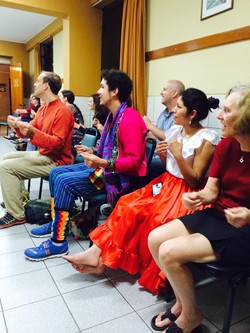
Sharing dance, music, and laughter. Photo by Rebecca Barnes.
I am aware that we all have different learning styles, and I do not wish for there to be fewer lectures and treatises and articles on the crisis. This will help lead to real change and we cannot move forward without science, math, accurate knowledge.
On the other hand, I do wish for a radical increase in the amount of community practice spaces at these conferences and gatherings. I want different ways of knowing, also.
Where are the group break-outs for multi-lingual protest singing, where we can learn one another’s songs?
Where are the prayer spaces where we can pray together across national and religious identity, lifting up in silence or movement or noise, the cries and commitments of our beings?
Where are the blank canvases and art supplies so we can create together the world we want to see?
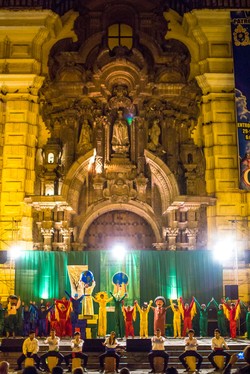
Children enacting a story of color, movement, and peace. Photo by Joe Tobiason.
Where is the circular seating so we can see one another’s eyes as we talked, read one another’s body language?
Where in the official settings are the voices of women, indigenous leaders, and residents of toxic communities given voice? Must they fit into our folding-chair conference set-up, placed at a straight table behind a microphone and name sign, using Western, male speech patterns in order to be heard?
I need more. We need more. In order to change, we have room to grow. We need more voice and energy and movement and heart not just in the People’s Summit, but also inside the COP 20 and all the side event conferences.
Sister Naraine invited us to practice consciousness of our spiritual connection to the earth (rather than simply doing action based on “principle”). Dr. Nigel Crawhal encouraged us to connect to the energy of the world with our own creative flame. These are the missing pieces, I believe; these are the growing needs for the climate justice movement. We need to commit hearts, hands, bodies, and spirits—not just minds.
In this Advent season we are awaiting an incarnate Christ, a God-with-us. We profess to believe in a material, physical love, a God who took on flesh. Climate justice work must do no less. It must take on flesh, use music, art, dance, rhythm, diverse voices, the power of relationships. Conscious of our kinship with all of life, let us claim our place in God’s earthy, material world. Let us embrace all of our senses and all ways of knowing so that we might more deeply transform ourselves and in the end, hopefully, the world.
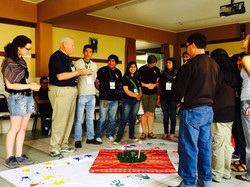
Group art project/devotional with Peruvian, Bolivians and North Americans. Photo by Rebecca Barnes.